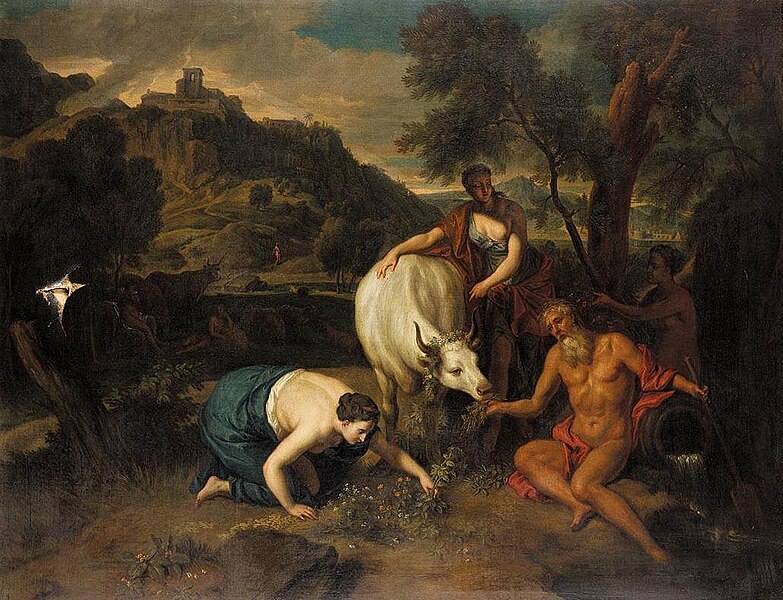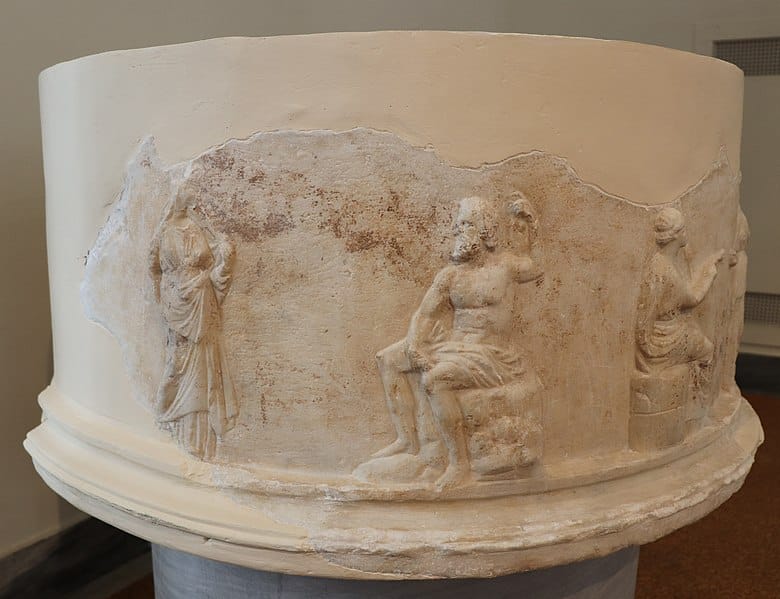In the vast tapestry of Greek mythology, Inachos stands out as a primordial river god, a deity whose tales flow through time like the waters of his namesake river. As we delve into his story, we’ll uncover the ripples of his influence, the currents of his relationships, and the depths of his significance in the ancient world.
Inachos Key Facts
| Parents | Oceanus and Tethys |
| Partners | Melia |
| Siblings | Other river gods |
| Offspring | Io, Mycene, and others |
| Other names | None |
| Roman name | Inachus |
| The God of | River Inachos |
| Symbols | River, Bull |
Name and Etymology
Inachos, derived from ancient Greek, is closely associated with the river that bears his name. The etymology, while not entirely clear, suggests a connection to water and flow. In Roman mythology, he is known as Inachus. Throughout various texts and tales, he doesn’t have many epithets or alternative names, which is quite unique for a deity of his stature. This singularity in nomenclature might hint at his primordial nature and the importance of his role in the pantheon.
The name’s simplicity and direct association with a natural element, the river, emphasize the god’s foundational role in the world of Greek mythology. It’s fascinating to note that while other gods have numerous names and titles, Inachos remains steadfastly associated with his river, underscoring his elemental significance.
Inachos Origins
Inachos, beyond his divine status as a river god, also holds a significant place in the annals of Greek history as a legendary king of Argos. The intertwining of his roles as both deity and king showcases the rich tapestry of Greek mythology, where divine and mortal realms often meld.
Born to the Titan deities Oceanus and Tethys, Inachos is one of the many river gods, but his association with Argos sets him apart. As the first king of Argos, he was said to have brought civilization, laws, and structured governance to its people. Under his rule, Argos flourished and became one of the major city-states in ancient Greece. His legacy as a king is deeply rooted in the region’s history, with many subsequent rulers claiming descent from him to legitimize their reign.
The Daemones, or spirits, in Greek mythology often played roles in shaping the characteristics and stories of such deities. In the case of Inachos, his spirit might be seen as the embodiment of the river’s flow, its nourishing properties, and its significance to the regions it traversed. But beyond that, his spirit also resonated with leadership, justice, and the advancement of civilization.
His dual role as a river god and a king is a testament to the multifaceted nature of Greek myths. While he was revered for the life-giving properties of his river, his contributions as a king made him an enduring figure in the cultural and historical landscape of Argos.
Inachos Lovers and Children
Inachos’s relationships, both divine and mortal, weave a complex web of tales that ripple through Greek mythology. While his union with the nymph Melia is the most renowned, he had other relationships that bore significant offspring, each leaving their mark on the mythological landscape.
Melia
Melia, a nymph, was one of Inachos’s most notable consorts. Their union symbolized the natural harmony between rivers and the nymphs that often inhabited their waters. Together, they had several children, with Io being the most famous due to her entanglements with Zeus. However, their lineage didn’t stop there.
Io

Io, the daughter of Inachos and Melia, became a central figure in several myths. Her beauty caught the attention of Zeus, leading to a series of events that saw her transformed into a heifer and pursued across lands by a persistent gadfly. This tale not only underscores the perils of attracting Zeus’s attention but also highlights the interconnectedness of various myths, with Inachos’s lineage playing a pivotal role.
Other Offspring
Apart from Io, Inachos and Melia were blessed with other children, each carrying forward the legacy of their divine parentage. Mycene, another of their daughters, was of such importance that the city of Mycenae was believed to have been named after her. This city would later become a significant center of Greek civilization, further emphasizing the impact of Inachos’s lineage.
Phoroneus, another offspring of Inachos, was known as the “first man” of Argos. Like his father, he played a pivotal role in the development of the region, introducing fire and establishing laws and governance. His contributions to Argos’s growth and prosperity further solidified the importance of Inachos’s descendants in both myth and history.
Depiction And Characteristics
Inachos, like many river gods, is often depicted as an elderly man with a flowing beard, symbolizing the continuous flow of the river. He might also be shown holding a cornucopia or a reed, both symbols of abundance and nature. The bull, representing his daughter Io’s transformation, is another symbol frequently associated with him.
While not as prominently featured as some other gods, what we glean about Inachos’s personality comes from his interactions and the tales of his descendants. He is often seen as a nurturing figure, representing the life-giving properties of his river. His reactions to the trials faced by his daughter Io also paint a picture of a protective and caring father.
Inachos Powers and Symbols
He primarily had dominion over the waters of his river. He could control its flow, potentially causing it to flood or dry up. Additionally, as a primordial deity, he possessed the ancient magic of the Titans, though specific feats or displays of this power are not frequently mentioned in myths.
The primary symbols associated with Inachos are the river and the bull. The river, naturally, represents his primary domain and his life-sustaining properties. The bull, on the other hand, is a nod to the tale of his daughter Io and her transformation, a pivotal story in his mythological narrative.
Inachos Roles And Responsibilities
As the god of the River Inachos, he was responsible for its flow, ensuring that its waters reached all those dependent on it. Beyond this, his role intertwined with the fates of his descendants, particularly Io. Through her, his influence extended to other myths and legends, making him an indirect but significant player in the larger tapestry of Greek mythology.
Myths about Inachos
Inachos, while not as omnipresent as some other figures in Greek mythology, has been central to a few captivating myths that highlight his significance and the intertwining of his roles as both deity and king.
The Tale of Io
One of the most enthralling myths involving Inachos revolves around his daughter Io. Zeus’s infatuation with Io led him to transform her into a heifer to shield her from Hera’s jealousy. Hera, not easily fooled, sent a gadfly to torment Io, causing her to wander across lands in distress. Inachos’s role in this tale is one of profound anguish. As he searched for his transformed daughter, his waters are said to have swelled with his sorrow, symbolizing a father’s deep love and concern for his child.
The Dispute of Hera and Poseidon

Another significant myth that casts Inachos in a pivotal role is the disagreement between Hera and Poseidon over the land of Argos. Both deities claimed the region as their own, and to resolve the dispute, they sought the judgment of the river gods, including Inachos. Despite the potential wrath of Poseidon, the god of the sea, Inachos and the other river gods favored Hera, affirming her dominion over Argos. This decision was not without its consequences. Enraged by the verdict, Poseidon dried up the waters of Inachos, turning the once-mighty river into a mere trickle. This myth not only underscores the importance of Inachos in the divine realm but also highlights the intricate relationships and power dynamics among the gods.
Inachos In Ancient Greek Religion
The River Inachos itself was a natural shrine to the god. However, there were also temples and sanctuaries dedicated to him, particularly in regions where the river was a central lifeline. These sites would often be places of worship, where offerings were made to appease the god and ensure the continuous flow of the river.
Representations Of Inachos In Art
Inachos, while not as frequently depicted as some other gods, can be found in various ancient artworks. He’s often shown in relation to his river or alongside other river gods, emphasizing his role in the natural world.
Mentions in Ancient Texts
Inachos, given his dual significance as both a deity and a legendary king, finds mention in several ancient texts. These references not only underscore his importance but also provide insights into how he was perceived by different authors and during various periods.
Pausanias’ “Description of Greece”
Written in the 2nd century AD, Pausanias’ work offers a detailed account of ancient Greece’s geography, temples, and traditions. Inachos is mentioned in relation to the land of Argos and its history.
“The river, which in ancient times was, they say, called Inachos, and the land, which was waterless and named Inachia after the river, were named Argos and Argolis after the son of Zeus.”
Ovid’s “Metamorphoses”
Ovid, a Roman poet writing in the 1st century AD, elaborates on various myths, including the tale of Io in his “Metamorphoses.”
“Jupiter had changed her form, made her a sleek cow, so Juno could not punish her; she never was deceived by this pretense.”
Apollodorus’ “Library”
Apollodorus, writing in the 2nd century BC, provides a comprehensive account of Greek myths and legends. His “Library” touches upon Inachos’s lineage and his significance in the genealogy of Greek heroes and gods.
“Io was the daughter of Inachos and was loved by Zeus. When Hera became suspicious, Zeus changed her into a white cow.”
Hyginus’ “Fabulae”
Hyginus, a Latin author from the 1st century BC, in his collection of myths titled “Fabulae,” also recounts the tale of Io and references Inachos as her father.
“When Juno saw that Epaphus was born from a cloud, and Inachos had nursed him, she realized that he was the son of Jupiter.”
Frequently Asked Questions
Inachos is best known as the primordial river god of the River Inachos and for being the father of Io.
He was the son of the Titan deities Oceanus and Tethys.
Yes, he was notably involved with the nymph Melia, and they had several children together.
Often as an elderly man with a flowing beard, symbolizing the river’s continuous flow.
The river and the bull are his primary symbols, representing his domain and the tale of his daughter Io, respectively.
While not one of the Olympian gods, as a primordial deity and river god, he held significant importance in regions where his river flowed.
Featured Image Credit: Victor Honoré Janssens, CC0, via Wikimedia Commons
